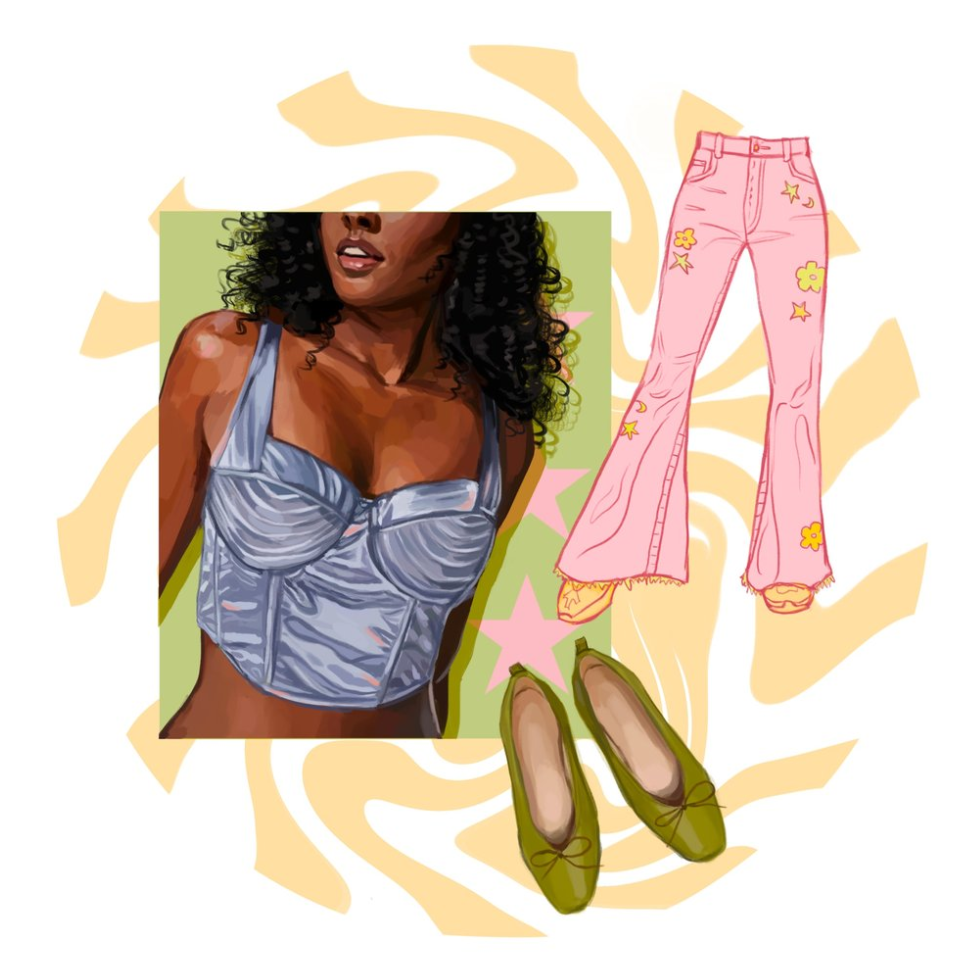Back from the Dead: The Origins of Re-Emerging Fashion Trends
In a world of fast fashion and social media, it can be difficult to keep track of the latest trends. What is even harder to understand is why “old” trends are re-emerging. Join Ava Edwards ’24 as she examines why corsets, tracksuits, bell bottoms, and more are back — at least for now.
ISABEL LI // FLAT HAT MAGAZINE
During the peak of COVID-19, Generation Z gained a newfound love for the corset, a fashion that fell out of style during the early 20th century. Styles from the ’60s and ’70s have also re-emerged in the form of bold, printed patterns and flared bell bottoms. Tracksuits and tie-dye are back too.
The return of vintage can occur on an individual level as children and grandchildren inherit clothes or thrift; this return can also occur on a societal level when well-known designers feature vintage pieces on the runway or red carpet, catapulting a style back to the forefront of fashion. And sometimes, old styles re-emerge from the dead with seemingly little explanation.
While fashion comebacks depend on numerous economic, social, and political factors, the simplest explanation is that fashion is cyclical — whether it’s a small accessory like the scrunchie or an entire movement like the return of the Y2K aesthetic, many trends cycle through popularity every 20 years, helping explain why many of the styles popular in 2003 are currently making a comeback. This is especially apparent when considering that, according to The Zoe Report, “velour tracksuits were up [in popularity] 41% from 2019.” Tracksuits were a staple in the early 2000s, with celebrities like Paris Hilton and Britney Spears often sporting these luscious looks. To Gen Z, young children in the early 2000s, tracksuits appear new, allowing the industry to reintroduce them and turn a profit.
Another explanation for the recycling of fashion that characterizes the industry is nostalgia — right now, millennial nostalgia. Recent studies have even suggested that millennials may be the most nostalgic generation to date, and this desire to return to simpler times affects the fashion industry, not only in terms of keeping up with millennial demand but also in that many from this generation now hold prominent positions in the design and fashion worlds.
Not only millennials are influencing the fashion industry: Gen Z is also dictating trends. An article from The Guardian argues that, due to COVID-19 and the climate crisis, Gen Z, particularly those ages 18-24, have turned to a “buy less, buy better” approach to shopping, rejecting the unsustainable, traditional apparel shopping habits of the past. In short, Gen Z’s fashion preferences may have been “shaped by the ‘Blue Planet effect,’” which, in turn, affects the fashion industry as brands try to meet this demand for sustainable clothing.
Thrifting — an alternative to name-brand stores — has also become a popular trend. According to the Royal Society for the Encouragement of Arts, Manufacturers and Commerce, “28% of people are recycling or reusing more clothes than normal and 35% of women intend to buy fewer clothes in the future,” thanks in part to Gen Z’s influence. Thrifting reintroduces old fashions to the populace as people donate (and others buy) their old clothes, allowing outdated styles to make a comeback among younger generations of consumers.
Other social factors affect the popularity of certain styles. For example, during the Civil Rights era, t-shirts sporting important figures or movement names were popular, and those who attended protests had shirts and other memorabilia made especially for the occasion — buttons too were popular items to hand out to support the protests. After the murder of George Floyd at the hands of police in 2020, Black Lives Matter staged protests nationwide. Many who participated in these protests wore solid black t-shirts, hats, buttons, and other articles of clothing with the BLM slogan. This political movement — much like the ones of the ’60s — also impacted the fashion landscape, with clothing brands rushing to meet the demand for Black Lives Matter merchandise, not only as a way to express their support for the movement but also to turn a profit.
Trends repeat over history. Given the influence of social media, trends are flitting in and out of existence at a dizzying rate, perhaps faster than ever, making predicting upcoming trends even more difficult. There does seem to be one guarantee, though — old styles always come back in style, at least in some form.

